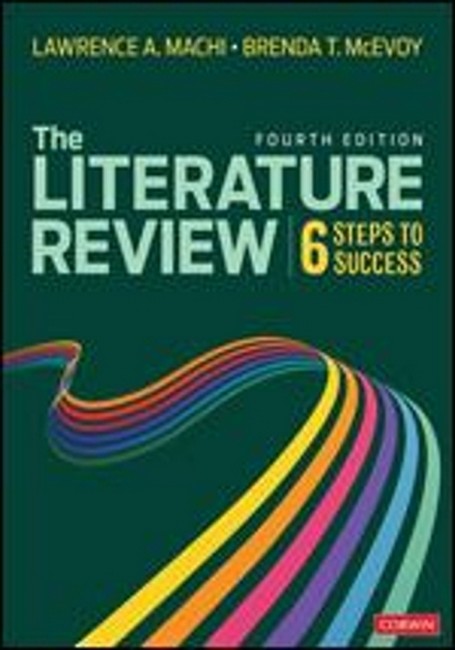Literature Review Flow Chart Preface Acknowledgments About the Authors Introduction: Doing and Producing a Literature Review Key Vocabulary Introduction Overview The Purpose of a Literature Review The Literature Review Defined The Literature Review Process Mindset: Personal Dispositions on Thinking, Doing, and Deciding The Ethics of Reviewing the Literature Reflective Oversight Plan Wisely Before You Begin Summary Checklist Reflective Exercise 1. Step 1: Select and Define a Topic Key Vocabulary Chapter Overview Task 1. Identify a Subject for Study Task 2. Translate the Personal Interest or Concern Into a Research Query Task 3. Link the Research Query to the Appropriate Discipline Task 4. Write the Preliminary Research Topic Statement Summary Checklist Reflective Exercise 2. Step 2: Develop the Tools of Argumentation Key Vocabulary Chapter Overview Concept 1. Building the Case for a Literature Review Concept 2. Arguments-the Basics Concept 3. Evaluating the Basic Parts of an Argument Concept 4. Understanding Claims Concept 5. Building Evidence Concept 6. Warrant-Logically Connecting the Evidence to the Claim Concept 7. Complex Claims Summary Checklist Reflective Exercise 3. Step 3: Search the Literature Key Vocabulary Chapter Overview Task 1. Select the Literature to Review Task 2. Conduct a Literature Search Task 3. Refine Your Topic Summary Checklist Reflective Exercise 4. Step 4: Survey the Literature Key Vocabulary Chapter Overview Task 1. Assemble the Collected Data Task 2. Organize the Information Task 3. Analyze the Patterns of Data Summary Checklist Reflective Exercise 5. Step 5: Critique the Literature Key Vocabulary Chapter Overview What Is a Literature Critique? Concept 1. Making the Case for the Literature Review Concept 2. Descriptive Argument Patterns: Factual Reasoning Concept 3. Implicative Argument Patterns: Implicative Reasoning Concept 4. The Implicative Argument: Nine Basic Patterns Concept 5. Backing Doing a Critique of the Literature: Building the Advocacy Argument Task 1. Determining the Implicative Logic Pattern Inferred by the Topic of Study Task 2. Reframe Claims to Meet the Prerequisite Conditions Identified by the Selected Logic Type Task 3. Build the Advocacy Argument Concept 6. Fallacies Concept 7. The Case Is Everything Summary Checklist Reflective Exercise 6. Step 6: Write the Review Key Vocabulary The Writing Process: Overview Task 1. Write to Understand Task 2. Write to Be Understood Style Manuals Checklist Reflective Exercise Last Words Supplements Supplement A The Role of the Literature Review Supplement B Literature Review 101 Supplement C Writing a Journal Supplement D SQRRR Glossary References and Further Reading Index
Request Academic Copy
Please copy the ISBN for submitting review copy form
Description
This book is clearly outlined with easy-to-understand steps supported by wonderful visuals. The key vocabulary, tips section, and checklist all provide tremendous support to any reader wanting to take the needed steps to write a meaningful literature review. This book provides sections that are concise and to the point, making it very easy for readers to skim and refer back to as needed. I commend the authors for presenting such a complex task with so much simplicity. The exercises provided are a great resource for the reader, as well as to a professor who wants to use this book as a text and assign the exercises as class activities . . . I will be sharing this book with colleagues and recommending it to my graduate students. I will also be considering how I can incorporate this book into classes that I teach. -- Rebecca Brooks, Associate Professor The strengths of The Literature Review include visuals, graphic organizers, checklists, practice activities, chapter structure, and glossary. -- Jennifer Shettel, Professor of Literacy Education Major strengths are the detail and explicitness of the narrative. Everything is spelled out and there are lots of graphics to present a visual support for the content. The book does not skip anything but also does not talk down to the reader. -- Lori Helman, Professor, Curriculum & Instruction Clear, thorough, accessible, easy to read with good examples. Love the mapping in Step Three! The authors do an excellent job of discussing ideas, strategies, and tips. Logical, clear, and helpful conclusions are made throughout. -- Linda R. Vogel, Professor of Education Leadership There is a clear framework for critically thinking about and applying a 6-step process for conducting a literature review . . . Unlike any other book, it provides a deep dive examination of how to approach and complete a high-quality literature review via a systematic critical thinking process. -- Dr. Jacqueline Thousand, Professor Emerita

